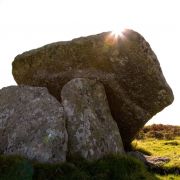Tregiffian Burial Chamber
The 15’long chamber was constructed from large upright granite slabs, roofed by four (perhaps originally five) even larger ones spanning around 6 feet. The interior also contains some sections of dry stone walling. One of the upright stones was highly decorated, an unusual practice in this part of the British Isles, with both circular and elongated cupmark hollows. Numbering 25 in total, it has been speculated that the 12/13 combination is directly connected to the cycles of the moon, being that in any given year there are 13 full moons and 12 new moons, or vice versa. Such significance was attributed to this stone that the original was removed to the safety of the Royal Cornwall Museum in Truro, and that which we see ‘in situ’ is a cast replica.
Upon investigation of the site, evidence of human cremation and burial were discovered. In 1840, W.C. Borlase found a large amount of ash and bone fragments lying underneath dislodged stones, along with shell sand he claimed had come from Porthcurno (not the nearest sand gathering location to the barrow). Deeper excavation in the 20th Century uncovered two pits. Such pits were typical of chambers such as Tregiffian for the burial of cremated remains, and one of the pits even contained an undamaged funerary urn still bearing ash and bone.






